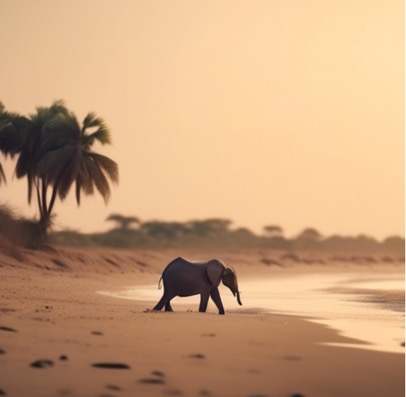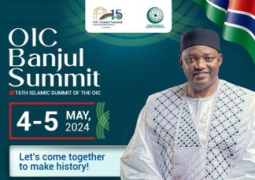
Among African nations, The Gambia stands out not for its progress, but for its immense untapped potential, moated by naturally endowed comparative advantages. A concerted rebranding effort from a cheap beach and sex tourism destination to a high-value tourism destination could sustainably generate between US$500-700 million per annum in revenue for the country. This represents a significant portion of the national GDP and could profoundly impact The Gambia’s economy.
Strategic Vision for High-Value Tourism
The TTDI report highlights that 16 out of 19 African countries have improved their scores since 2019, reflecting advancements in environment, policies, infrastructure, and resources in their travel and tourism sectors. South Africa, Mauritius, and Ghana stand out, with Mauritius being the region’s most tourism-dependent economy in 2022.
The success of these countries is largely attributed to strategic planning. Each has developed and executed multi-year tourism campaigns tailored to their unique strengths. For instance, Ghana’s cultural tourism initiative, the "Year of Return", has been a remarkable success, alongside South Africa’s focus on wildlife and MICE tourism, and Mauritius’s MICE tourism strategy.
The Gambia's strategic vision for revitalizing its tourism industry should focus on high-value products such as wildlife, sports, and MICE tourism (Meetings, Incentives, Conferences, and Exhibitions). This new direction can jump-start significant national revenues, improve job creation, and reduce poverty.
According to Rwanda’s Chief Tourism Officer, Michaella Rugwizangoga, Rwanda has successfully implemented a similar strategy to attract a record-breaking 1.5 million visitors in 2023, which generated a staggering US$620 million. The Gambia processed 206,936 visitors during the same period, according to the World Bank’s Economic Update (Spring 2024).
MICE Tourism
The global business tourism market is projected to grow from $970.76 billion in 2024 to $1,932.73 billion by 2032. Africa is poised to increase its market share due to the rising demand for unique conference experiences. The recent development of the $50 million SDKJ International Conference Centre in The Gambia positions the country to capitalize on the expanding MICE market.
Besides the prerequisite facilities and connectivity, the best conference locations offer the best and most varied and enjoyable experiences outside of the conference. This is why Las Vegas, Singapore, Paris, Barcelona, and Dubai are the top 5 MICE Tourism cities globally. Each city provides a plethora of unique experiences for business travellers to enjoy – from shopping, fine dining, and nightlife, to lavish nature-based excursions and sports.
From a conference goers’ perspective, the location of the conference and the social events and excursions surrounding the conference can be a key determinant of whether they will attend the conference, especially with virtual meeting options so readily available.
In Africa, Rwanda is a prime example of successful MICE tourism. Kigali, the capital city, has become a leading destination for international conferences and events thanks to the Kigali Convention Centre, excellent infrastructure, complementary tourism products (e.g. Gorilla/wildlife tourism), and strong government support. Major events like the African Union Summit, African CEO Forum, and the NBA’s Basketball Africa League Final have been hosted there, boosting the local economy and international reputation.
The Gambia can follow this model with its new SDKJ International Conference Centre, tapping into the growing global MICE market, which can in turn bolster other complementary tourism products and ultimately significantly boost its economy.
Bush-to-Beach Tourism
Globally, nature tourism generates over $600 billion, with wildlife tourism contributing to nearly 22 million jobs. Africa's wildlife tourism sector alone generates around $142 million in entrance fees for protected areas. The Gambia, however, derives less than 15% of its total tourism receipts from wildlife.
The Gambia has the potential to embrace a bush-to-beach tourism strategy, seamlessly blending wildlife and nature experiences ("bush") with coastal and beach attractions ("beach"). This integrated approach capitalizes on the country's diverse natural landscapes to offer tourists a distinctive and multifaceted travel experience. By providing complementary activities in different environments, this strategy aims to attract diverse types of tourists, prolong their stays, and increase overall spending.
Countries like Kenya, Tanzania, Namibia, Mozambique, and South Africa have successfully implemented the bush-to-beach tourism strategy, serving as prime examples of its effectiveness.
For instance, Mozambique entices visitors with vibrant marine life and breathtaking beaches in the Bazaruto Archipelago, complemented by the rich biodiversity of Gorongosa National Park, appealing to both wildlife enthusiasts and beach aficionados.
Whereas in The Gambia, tourists could prospectively embark on world-class safaris and birdwatching in the Kiang West National Park and Boa Bolong Wetland Reserve before unwinding on the pristine beaches of Jinack Island or the bustling Kotu beaches along the Gambian coast. The country can seamlessly integrate wildlife adventures with coastal relaxation through comprehensive high-value travel packages.
Sports Tourism
Sports tourism, particularly golf tourism, presents another high-value opportunity. The global golf tourism market generates $44.6 billion annually and appeals to tourists with high disposable incomes. Morocco's rapidly expanding golf market, which has nearly doubled its inventory in the past decade, highlights the potential for The Gambia. By leveraging its rich history in golf, institutionalized by the late President Dawda K. Jawara, The Gambia can attract high-value sports tourists.
Digital Nomads
The Gambia is well positioned to tap into the burgeoning market of digital nomad tourism, thanks to its affordable living costs, stunning landscapes, and tropical climate. With English as its official language and located in a favourable time zone, The Gambia offers an ideal environment for remote work and networking. Its strategic position and government support further enhance its appeal.
To attract digital nomads, The Gambia can improve internet connectivity, create coworking spaces, promote longer stays, build community, showcase unique attractions, ensure safety, and simplify visa processes. Embracing digital nomad tourism would diversify the country's tourism sector and fuel economic growth.
The global rise of remote work and digital nomadism, with over 35 million individuals identifying as digital nomads in 2023, underscores the trend's significance. Notably, a substantial proportion of digital nomads hold tertiary qualifications, with 45% reporting annual earnings between US$100,000 – 1,000,000, according to Statista.
Crippling Challenges and Headwinds
While The Gambia possesses inherent natural advantages with significant growth potential, its tourism industry is confronted by several significant challenges that impede its development. There are two
- Poor Infrastructure and Accessibility: The inadequacy of infrastructure, encompassing roads, river transportation (such as ferries), and airports, severely limits tourists' ability to access the country. A Dakar-based entrepreneur highlights this issue, noting the reluctance of middle-class families in Senegal to visit The Gambia due to concerns about unreliable ferries and consistently delayed, costly flights. “There are tens of thousands of middle-class families in Senegal that would love to visit The Gambia but are deathly afraid the ill-fated ferries and perpetually late and expensive flights to The Gambia. I can travel to Barcelona for the same price as flying to The Gambia, which is only 20min flight away”.
- Synthetic Seasonality: The Gambia is truly a year-round tourism destination, however the sector in experiences pronounced seasonality, with peak tourist arrivals occurring during the winter months. This pattern is primarily attributed to two factors: i) European Charter Tour Operators, like Thomas Cook, positioning The Gambia as an affordable winter beach destination, with tourists redirected to Mediterranean destinations during the summer, and ii) limited year-round air connectivity, with approximately half of flights to The Gambia operated by charter flight providers. This entrenched seasonal reliance leads to fluctuations in revenue and employment opportunities.
- Poor Branding, Marketing and Promotion: The Gambia has not historically controlled the promotional narrative of its tourism product. It has largely deferred this to third parties, such as Tour Operators, to define and its reputation has infamously devolved to a destination for sex tourism. The stigma of the prevalence of sex tourism can not only deter other forms of tourism, but it can also hamper foreign investment into the country in general.
Effectively addressing these challenges necessitates collaborative efforts from the government, private sector, and local communities to improve infrastructure and accessibility, diversify tourism offerings, and enhance the brand of Gambia tourism.
Conclusion
Africa's travel and tourism sector has made remarkable strides, with countries like Ghana, South Africa, and Mauritius leading the way. These nations exemplify how strategic planning, effective policies, and targeted investments can transform tourism into a major driver of economic growth.
In contrast, The Gambia faces significant challenges, including poor infrastructure and limited air connectivity. However, by developing a strategic vision that focuses on high-value tourism segments and improving connectivity, The Gambia can unlock its tourism potential.
The journey to revitalization requires a clear vision, sustained investment, and the collective will to overcome challenges. The rewards—a thriving tourism industry that boosts economic growth, creates jobs, and enhances The Gambia’s global standing—are well worth the effort. By embracing this path, The Gambia can transform from a stagnant outlier to a shining example of success in Africa’s tourism renaissance.
Read Other Articles In Opinion





